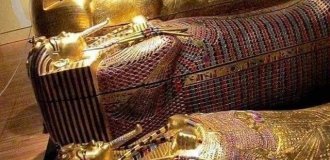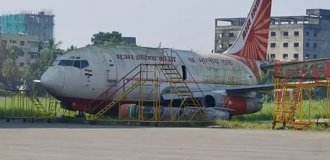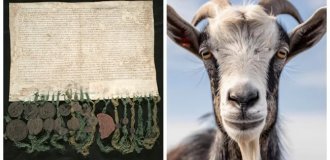Yuri Alekseevich Gagarin - the first cosmonaut (22 photos)
“Decades will pass, centuries will pass, man will enter other planets, going beyond the boundaries of the cosmic system, much will be erased from the memory of mankind, but the name of Yuri Gagarin, who for the first time overcame gravity and broke into space, will forever remain in the annals of the history of earthly civilization” (Academician of Sciences USSR B.I. Petrov).
Yuri Alekseevich Gagarin was born on March 9, 1934 in the village of Klushino, Gzhatsky district of the Western (now Smolensk) region of the RSFSR. Russian. His father, Alexey Ivanovich Gagarin, is a carpenter, his mother, Anna Timofeevna Matveeva, is a dairy farm worker.
The future cosmonaut spent his childhood in the village of Klushino. On September 1, 1941, the boy went to school, but on October 12, the Germans occupied the village, and his studies were interrupted. For almost a year and a half, the village of Klushino was occupied by German troops. When Soviet troops liberated the village, school resumed. Yuri has loved sports since his school years, especially basketball.



In 1945, the Gagarin family moved to Gzhatsk (now the city of Gagarin). After graduating from sixth grade, Yuri entered the Lyubertsy vocational school and at the same time attended an evening school for working youth. After graduating from the seventh grade, he simultaneously graduated from college with honors as a molder-foundry worker.
In August 1951, Gagarin entered the Saratov Industrial College. His passion for aviation began in Saratov: he entered the Saratov flying club. In 1955, Yuri Gagarin graduated with honors from the technical school and made the first independent flight on a Yak-18 aircraft. In total, Yuri Gagarin performed 196 flights at the flying club and flew 42 hours 23 minutes.
In 1955, Gagarin was drafted into the army and sent to Chkalov (now Orenburg), to the 1st Military Aviation Pilot School named after K. E. Voroshilov. He studied with the then famous test pilot Ya. Sh. Akbulatov. Two years later, Gagarin graduated from college with honors and for two years served in a fighter regiment of the Northern Fleet near Murmansk, flying MiG-15bis aircraft.
In 1957, he married Valentina Ivanovna Goryacheva, whom he met while still in Chkalov.
In 1959, Gagarin wrote a statement asking to be included in the group of cosmonaut candidates. A week later he was called to Moscow to undergo a comprehensive medical examination at the Central Research Aviation Hospital. At the beginning of the next year, another special medical commission followed, which declared Senior Lieutenant Gagarin fit for space flight. On March 3, 1960, by order of the Air Force Commander-in-Chief Konstantin Andreevich Vershinin, he was enrolled in the group of cosmonaut candidates, and on March 11, Gagarin and his family left for a new duty station. On March 25, regular classes began under the cosmonaut training program.



On April 12, 1961, for the first time in the world, the Vostok spacecraft launched from the Baikonur Cosmodrome with pilot-cosmonaut Yuri Alekseevich Gagarin on board. For this flight he was awarded the title of Hero of the Soviet Union and the military rank of major ahead of schedule (he took off with the rank of senior lieutenant). From now on, April 12 is Cosmonautics Day.

For 4 months, the training of future cosmonauts took place in Moscow, and then the Training Center was transferred to a permanent location - in Zvezdny. The first housing stock was received nearby - apartments to accommodate the families of cosmonaut trainees and part of the families of the leading
In addition to Gagarin, there were other applicants for the flight - a total of twenty people (Air Force Group No. 1). According to Korolev’s decision, candidates were recruited specifically from fighter pilots: he believed that such pilots already had experience of overload, stressful situations and pressure changes. Selection for the first group of cosmonauts was carried out on the basis of medical, psychological and other parameters: age 25-30 years, height no more than 170 cm, weight no more than 70-72 kg, ability to adapt to altitude and stratospheric conditions, reaction speed, physical endurance, mental balance . The height and weight requirements arose due to the corresponding restrictions on the Vostok spacecraft, which were determined by the power of the Vostok launch vehicle. In addition, when selecting candidates, positive characteristics, party membership were taken into account (Gagarin became a candidate member of the CPSU in 1959, and joined the party in the summer of 1960), political activity, and social origin.
Out of twenty applicants, six were selected for the first flight. Then, out of six, three (cosmonaut, backup and reserve). Of course, people still ask the question: why Gagarin? I would like to note that, firstly, the choice was made exclusively right, and secondly, no matter who flew first, this question would remain. Let's read the psychological characteristics of Yuri Alekseevich Gagarin, then look at his open smile, read about his family - and this question will disappear by itself.

Psychological characteristics of Yu.A. Gagarin
He loves spectacles with active action, where heroism, the will to win, and the spirit of competition prevail. In sports games he takes the place of the initiator, leader, and captain of the team. As a rule, his will to win, endurance, determination, and sense of team play a role here. Favorite word is “work.” Makes sensible proposals at meetings. Constantly confident in himself and his abilities. Confidence is always stable. It is very difficult, in fact impossible, to bring him out of balance. The mood is usually a little upbeat, probably because his head is full to the brim with humor and laughter. At the same time, he is sober and reasonable. Endowed with boundless self-control. He endures training easily and works effectively. Developed very harmoniously. Sincere. Clean in soul and body. Polite, tactful, careful to the point of punctuality. Likes to repeat: “As taught!” Modest. He gets embarrassed when he overdoes it in his jokes. Yura's intellectual development is high. Excellent memory. He stands out among his comrades for his wide range of active attention, quick wit, and quick reaction. Assiduous. Carefully prepares for classes and training. Confidently manipulates the formulas of celestial mechanics and higher mathematics. He does not hesitate to defend the point of view that he considers correct. He seems to know more about life than some of his friends.


Flight
They were in a hurry to carry out the flight: the USSR took part in the space race, Korolev was in a hurry, since there was evidence that on April 20, 1961, the Americans would send their man into space.
The Vostok-1 spacecraft was launched on April 12, 1961 at 09:07 Moscow time from the Baikonur Cosmodrome; Gagarin's call sign was "Kedr". The Vostok launch vehicle operated without any problems, but at the final stage the radio control system, which was supposed to turn off the 3rd stage engines, did not work. The engine was turned off only after the backup mechanism (timer) was activated, but the ship had already ascended into orbit, the highest point of which (apogee) turned out to be 100 km higher than the calculated one. Departure from such an orbit using “aerodynamic braking” could take, according to various estimates, from 20 to 50 days. But the backup braking system was removed from the design of the Vostok-1 ship under construction. The latter decision was justified by the fact that when the spacecraft was launched into a low 180-200 kilometer orbit, it would in any case leave it within 10 days due to natural braking on the upper layers of the atmosphere and return to earth. Life support systems were also designed for the same 10 days.
In orbit, Gagarin carried out simple experiments: he drank, ate, and made notes in pencil. “Putting” the pencil next to him, he accidentally discovered that it instantly began to float away. From this, Gagarin concluded that it is better to tie pencils and other objects in space. He recorded all his sensations and observations on the on-board tape recorder. Before the flight, it was not yet known how the human psyche would behave in space, so special protection was provided to prevent the first cosmonaut, in a fit of insanity, from trying to control the flight of the ship. To enable manual control, he had to open a sealed envelope, inside of which was a piece of paper with a code that, by typing on the control panel, could unlock it.



The descent took place along a ballistic trajectory (like the rest of the spacecraft of the Vostok and Voskhod series), that is, with 8-10 times overload, for which Gagarin was prepared. There was a strong psychological stress - after the capsule entered the atmosphere, the hull of the ship caught fire (the temperature outside during descent reaches 3-5 thousand degrees), streams of liquid metal flowed down the windows of the windows, and the cabin itself began to crackle.
At an altitude of 7 km, in accordance with the flight plan, Gagarin ejected, after which the capsule and the cosmonaut began to descend separately by parachute. After ejection and disconnection of the air duct of the descent vehicle, the valve in Gagarin’s sealed spacesuit did not immediately open, through which outside air should flow, so Gagarin almost suffocated. The last problem in this flight was the landing site - Gagarin could parachute into the icy water of the Volga. Yuri was helped by good pre-flight preparation - by controlling the lines, he moved the parachute away from the river and landed 1.5-2 kilometers from the shore, not far from the city of Engels, Saratov region.
The Vostok-1 spacecraft with Yu.A. Gagarin on board made one revolution around the Earth and completed the flight at 10:55:34 in the 108th minute.
The first people who met the astronaut after the flight were the wife of a local forester, Anikhayat Takhtarova, and her six-year-old granddaughter Rumiya. Soon, military personnel from the division and local collective farmers arrived at the scene of events. One group of military men took guard over the descent module, and the other took Gagarin to the unit’s location. From there, Gagarin reported by phone to the commander of the air defense division: “Please convey to the Air Force Commander-in-Chief: I completed the task, landed in the given area, I feel good, there are no bruises or breakdowns. Gagarin."


Glory
Initially, no one planned a grand meeting for Gagarin in Moscow. Everything was decided at the last moment by N. S. Khrushchev.
On April 14, an Il-18 flew for Gagarin, and on the approach to Moscow, the plane was joined by an honorary fighter escort consisting of seven MIG fighters. The plane with the escort passed in ceremonial formation over the center of Moscow, over Red Square, then landed at Vnukovo airport, where a grand reception awaited Gagarin. A huge crowd of people, the entire leadership of the country, journalists and cameramen. The plane taxied to the central building of the airport, the ramp was lowered, and Gagarin was the first to descend. A bright red carpet was stretched from the plane to the government stands, and Yuri Gagarin walked along it (along the way his shoe lace came undone, but he did not stop and reached the government stands, risking tripping and falling) to the sounds of an orchestra playing the Soviet air march “We were born to make a fairy tale come true” and reported on his flight.

Further on, in the open ZIL-111V, Gagarin greeted those greeting him while standing. Congratulations were heard all around, many waved placards. A rally was held on Red Square, at which Nikita Khrushchev announced that Gagarin was awarded the titles Hero of the Soviet Union and “Pilot-Cosmonaut of the USSR.” The meeting grew into a spontaneous 3-hour demonstration, which Yuri Gagarin and the leaders of the Soviet state greeted from the rostrum of Lenin's mausoleum. The celebrations continued at a reception in the Kremlin, which was attended by many designers, whose names had not yet been officially announced. Leonid Brezhnev presented Gagarin with the Gold Star medal of the Hero of the Soviet Union and the Order of Lenin.
Trips to foreign countries followed one after another: everyone wanted to see the first cosmonaut and communicate with him. The first country Gagarin visited was Czechoslovakia. Then there were Bulgaria, England, Finland, Poland, Cuba, Brazil, Canada, Iceland, Hungary, India, Ceylon, Afghanistan. This is only in 1961! In subsequent years, he visited Egypt, France - more than 30 countries in total. Sometimes he had to perform 18-20 times a day.

After the flight
His life changed dramatically after the flight. So great was the desire of people to meet the first cosmonaut that for three years, meetings and trips took up most of Yuri’s personal time.
In 1964, Gagarin became deputy head of the Cosmonaut Training Center. He carried out extensive social and political work, being a deputy of the Supreme Soviet of the USSR of the 6th and 7th convocations, a member of the Komsomol Central Committee, and president of the Soviet-Cuban Friendship Society.


Cosmonauts German Titov and Yuri Gagarin on the podium

Gagarin studied at the Air Force Engineering Academy named after N. E. Zhukovsky and therefore did not have flight practice for some time, and his social activities also affected him. He made his first solo flight on a MiG-17 after the break in early December 1967. Landed on the second approach due to an incorrect landing calculation, typical for short pilots who had a break in flights. This became a reason for the authorities to fear losing the popular hero in the event of an accident. Gagarin was Vladimir Komarov's backup during the flight on the Soyuz-1 spacecraft; the flight was interrupted early due to a malfunction of the solar battery, and ended in the death of the cosmonaut due to malfunctions of the parachute system. It is possible that if Korolev had lived, Gagarin would have been the main pilot of Soyuz-1.
Yuri Gagarin sought to implement lunar space flights and, until his death, was a member of the crew of one of the upcoming lunar ships. Gagarin could not fly a fighter on his own, being the deputy head of the training center for flight training, and therefore achieved a referral to restore his qualifications as a fighter pilot.

Death
After defending his thesis at the Zhukovsky Academy, Yu. A. Gagarin began flight practice - training flights on the MiG-15UTI aircraft (a training fighter with dual control - “spark”). Between March 13 and March 22, he made 18 flights with a total duration of 7 hours. Before independent flights, he had the last two control flights left - with the instructor pilot, regiment commander, Hero of the Soviet Union Vladimir Seregin.
On March 27, 1968 at 10:18, Gagarin and Seryogin took off from the Chkalovsky airfield near Moscow to Shchelkovo. At the time of takeoff, visibility conditions were normal. Completing the task in the flight zone should have taken at least 20 minutes, but after four minutes (at 10:30) Gagarin reported to the ground that the task was completed, requested permission to turn around and fly to the base. After this, communication with the plane was lost.
When it became clear that the plane should have already run out of fuel, a search began in the flight zone, which lasted more than 3 hours. At 14:50, one of the helicopters managed to detect the wreckage of a MiG-15UTI aircraft approximately 65 km from the airfield, near the village of Novoselovo, 18 km from the city of Kirzhach, Vladimir region. The next morning, a piece of Gagarin’s flight jacket with food stamps was found on a branch. Later, a wallet with a driver's license and a photograph of Korolev was discovered.























